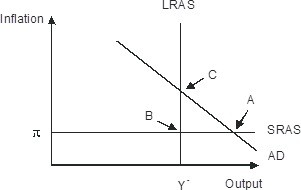A bank creates money when it:
a. gets new checkable deposits which the depositor formerly held as cash.
b. has a loan paid off, which creates excess reserves for the bank.
c. makes a loan from its excess reserves.
d. holds back excess reserves because of an increase in the required reserve ratio.
e. gets more excess reserves because of a decrease in the required reserve ratio.
c
You might also like to view...
Refer to the figure below. In response to gradually falling inflation, this economy will eventually move from its short-run equilibrium to its long-run equilibrium. Graphically, this would be seen as 
A. long-run aggregate supply shifting leftward B. Short-run aggregate supply shifting upward C. Short-run aggregate supply shifting downward D. Aggregate demand shifting leftward
Import Substitution (IS) strategies have been defended on the basis of
a. export pessimism b. the desire to industrialize c. the potential for learning by doing d. the desire to save on foreign exchange e. all of the above
The sharp rise in the debt-to-GDP ratio in 2008-2009
a. was exclusively automatic due to the effect of declining income on government outlays and tax revenues. b. was exclusively due to an aggressive fiscal policy. c. was exclusively due to military expenditures. d. was partly automatic due to the effect of declining income on government outlays and tax revenues, and partly due to an aggressive fiscal policy. e. was exclusively due to foreign aid expenditures.
Which one of these is not a characteristic of capitalism?
A. Central planning B. Private property C. The price mechanism D. Competition